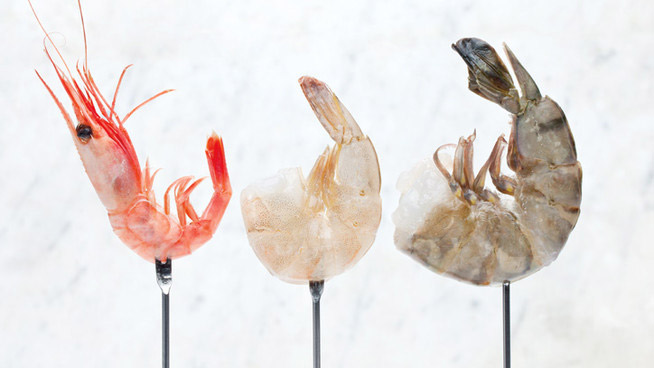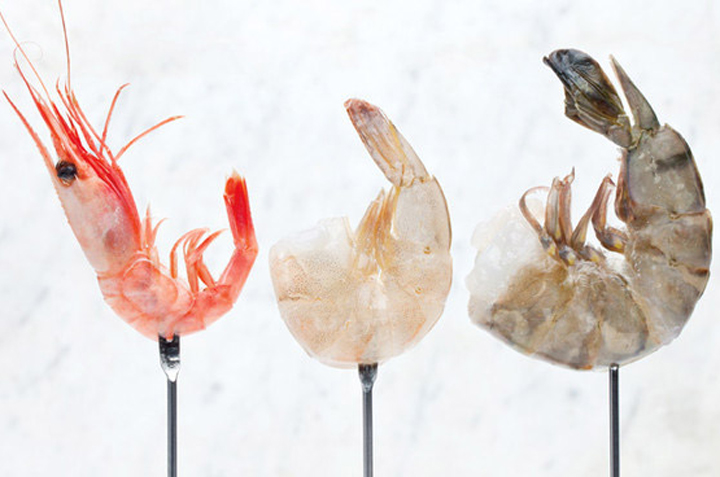Types of shrimp
There are more than two thousand species of shrimp, but the reality in the grocery store is quite different. Roughly speaking, there are only three choices: wild coldwater Northern shrimp, farm-raised white shrimp and tiger shrimp, available in various sizes and products.
COLDWATER NORTHERN SHRIMP (Pandalus borealis)
This small, pink shrimp is found in the cold waters of the North Atlantic, North Pacific and Arctic Oceans. The Gulf of St. Lawrence and Canadian Atlantic shrimp trawl fisheries run from April through November. Nicknamed the Matane shrimp (since the first processing plant was located in Matane, Quebec), this shrimp is always sold cooked, frozen or thawed. In the springtime, with a little luck, you can also find it fresh, cooked and unpeeled. It's a real treat to eat with your fingers! Coldwater shrimp contains more omega-3 fat (great for your health) and protein than farm-raised shrimp. In addition, it is not treated with sodium phosphate (a preservative used to treat farmed shrimp) and is considered to be a sustainable seafood choice. There are so many good reasons to choose it more often.
WHITE SHRIMP (Penaeus vannamei)
This shrimp comes in a variety of sizes and products (raw, cooked, peeled and unpeeled, with or without the tail). It is sold either frozen or thawed and is the kind most often found in grocery stores and at fishmongers. Imported mainly from China, Thailand, India or Bangladesh, this shrimp is produced by aquaculture. It is treated with sodium phosphates to protect its colour and texture. This family of additives reacts with the shrimp's protein so that it loses less water during thawing and cooking. This treatment also gives it a sometimes metallic taste and translucent appearance.
TIGER SHRIMP (Penaeus monodon)
Tiger shrimp, not as widely available in stores, is the most consumed after white shrimp. It is also the biggest of all commercial shrimp. It is recognizable by its large size and striped shell. This plump type is the go-to shrimp when cooking skewers and for the barbecue.
American chain Red Lobster alone uses 44 million pounds of shrimp annually. In 2011, Americans ate more than 1 billion pounds of shrimp, or more than 4 pounds per person.
A question of size
All shrimp are classified by size. This is indicated by a sea of numbers (for example, 8-12, 16-20, 21-25, 41-50 up to 150-200) listed on the front of the package. These numbers list the count per pound (454 g). For example, 21-25 means there are between 21 and 25 shrimp per pound. The smaller the count, the larger the shrimp. This comes in handy when you have to calculate the number of shrimp needed per portion or to serve a given number of guests.
5 questions about shrimp
1. SHOULD YOU BUY FRESH OR FROZEN?
Don't look for fresh shrimp! Unless you live by the ocean or in the Gulf of St. Lawrence, it is virtually impossible to find shrimp that has not been frozen: it is extremely perishable. Whether it is raw or cooked, even seemingly "fresh" shrimp on display at the fishmonger is frozen product that has been thawed. Use thawed shrimp within 24 hours of purchase. If you buy frozen shrimp, choose a package that does not contain frost. The presence of frost means that the product has undergone changes in temperature and that the shrimp has lost water through evaporation. This shrimp is still edible, but its texture will not be optimal and it may show signs of freezer burn. We suggest two ways to safely thaw shrimp: the slow technique consists of thawing it overnight in the fridge, while the fast way consists of putting the shrimp in a bowl of cold tap water.
2. WHAT TO CHOOSE: RAW OR COOKED? PEELED OR UNPEELED? WITH OR WITHOUT THE TAIL?
It's a question of taste and intended use. In any case, it's important to remember that heat is shrimp's nemesis in cooking. It loses weight and volume when cooked too long and becomes tough and chewy. If you plan to make shrimp skewers on the barbecue, choose large or colossal-sized shrimp, unpeeled, because the shell and size will protect against drying. You can also find unpeeled, deveined shrimp, perfect to be marinated and cooked on the barbecue. If you are making a sauce dish, such as red curry shrimp or Asian stir-fry, use raw, peeled, medium-sized shrimp and add it at the last minute. You're wondering whether to offer shrimp with or without the tail? Not only does shrimp with a tail look better, it is easier and less messy to hold with the fingers.
3. SHOULD YOU REMOVE THE BLACK VEIN?
That black line is the shrimp's digestive tract. Cooked, peeled shrimp is almost always already deveined. Raw shrimp can sometimes have a visible black vein. Removing it or not is more a question of aesthetics than taste. The best way to do so is to run a paring knife down the length of the shrimp's back to expose the vein, and then remove it by pulling gently with the tip of the knife.
4. WHY DOES SHRIMP CHANGE COLOUR WHEN COOKED?
Shrimp contains a pink pigment called astaxanthin. This pigment is attached to a protein, which masks its pink colour. This is why raw shrimp has a greyish colour. However, the protein is cleaved in the presence of heat. Its structure changes, it no longer masks the astaxanthin and the pink colour is revealed when cooked. Astaxanthin in wild shrimp comes from the microscopic algae on which it feeds. It is simply added to the feed of farm-raised shrimp.
5. DOES A SUSTAINABLE SHRIMP FISHERY EXIST?
Industry monitoring bodies, such as Seachoice, have given the green light to wild, trap-caught B.C. spot prawns (Northern coldwater shrimp), as well as Atlantic and Gulf of Mexico shrimp caught by trawlers, though these products are not easy to find. Northern coldwater shrimp received certification from the Marine Stewardship Council in 2008. As for popular white shrimp and tiger shrimp found at any grocery store, they are for the most part on the red "fish to avoid" list. While aquaculture has made these shrimp more affordable, it is criticized for causing many environmental problems: significant pollution at farming sites, lowering of groundwater levels, mangrove destruction, etc. What should you do? Look for products that display a blue "Certified Sustainable Seafood" label from the Marine Stewardship Council (msc.org) or a blue "Best Aquaculture Practices Certified" label (www.responsibleseafood.org). In the latter case, choose a product certified for the processing plant as well as the farm (this information is clearly indicated on the label).


